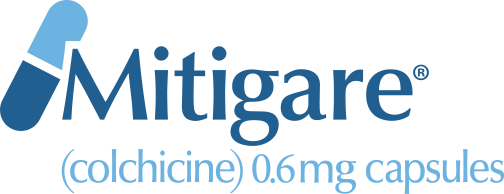
Gout and rheumatoid arthritis (RA) are forms of arthritis with similar symptoms and comparable patterns of flares and remission.1,2 They can seem so similar, in fact, they are sometimes mistaken for one another until a doctor provides the official diagnosis.3,4,5 In spite of their similarities, however, gout and RA are distinctly different conditions.1,2 Have you ever had pain, swelling and/or stiffness in a joint and wondered, “Could it be gout or rheumatoid arthritis?” If you have, read on to find out more about gout and RA, what causes these diseases and why it is so important to see a doctor for an accurate diagnosis and management advice.1,2
Causes
Although the symptoms of gout and RA can be similar, the causes are not1,2:
- Gout—Gout can develop when there is too much uric acid in the bloodstream.1 This excess uric acid, a condition called hyperuricemia, can cause urate crystals to build up in the body’s joints, fluids and tissues.1 These crystals can trigger episodes of sudden and intense joint pain.1
- RA—RA can develop when the body’s immune system attacks its own healthy cells by mistake.2 As a result, people who suffer with this autoimmune condition can experience painful swelling and stiffness in their affected body parts.2
Risk Factors
Gender, age, genetics, obesity, certain medical conditions and lifestyle have been associated with the risks of developing gout and RA.1,2
- Gender—Men are about three times as likely as women to be affected by gout.6 Women are two to three times as likely to be affected by RA as men.2 (The risk is even higher in women who have never given birth.2)
- Age—The risks of gout and RA both increase as a person gets older.1,2
- Genetics—People who have a family history of gout are more likely to develop the condition than those who do not.7 The same is true for people with a family history of RA.2
- Obesity— Obesity is a risk factor for both gout and RA.1,2 In fact, the heavier a person is, the higher their risk of developing these diseases.1,2
- Medical Conditions—Having certain medical conditions, such as congestive heart failure, hypertension (high blood pressure), diabetes or prediabetes or poor kidney function can increase a person’s chances of developing gout.1
- Lifestyle—Certain lifestyle factors, including diet and cigarette smoking, are associated with gout and RA1,2:
- A diet that includes purine-rich foods (such as red meat, certain kinds of seafood and/or organ meats, like liver) and alcoholic and/or sugary beverages can raise the uric acid level in the bloodstream and increase the risk of gout.7 (Recent research, however, has shown that genetics play a larger role in the development of gout than diet.8,9)
- Cigarette smoking has been shown to increase the risk of RA and can make the disease worse in people who already suffer with it.2 Smoking can affect their children’s risk of RA as well.2,10 A 2021 study found that the children of women who smoked were twice as likely to develop RA as those whose mothers avoided tobacco.10
Signs and Symptoms
The symptoms of gout and RA can be similar and include pain, swelling and stiffness.1,2,7 (Fatigue, weakness and weight loss are other possible symptoms of RA not shared by gout.1,2) It also should be noted that people with gout and people with RA can suffer with flares as well as periods of remission where they do not experience any symptoms.1,2 Because gout and RA can mimic one another, it is important to see a doctor (or specialist such as a rheumatologist) to get an accurate diagnosis.1,2
Sites
In most people, gout affects the big toe.7 However, it can occur in any joint including the ankles, knees, elbows, wrists and fingers.7 Like gout, RA also primarily attacks the joints.2 Unlike gout, however, RA often affects several joints at once—usually in the hands, wrists and knees.2 It also is not unusual for people with RA to have the same symptoms on both sides of the body (in both hands or both knees, for example).2
Diagnosis and Management
Gout and RA typically are diagnosed using X-rays and lab tests.1,2 For many people with gout, the condition is managed with urate-lowering therapy (ULT; allopurinol, for example) to reduce the amount of uric acid in the bloodstream.11 A colchicine product, such as Mitigare® (Colchicine) 0.6mg Capsules or Generic Colchicine 0.6mg Capsules, may help to prevent painful gout flares.11,12 Treatment for RA usually includes medications that slow down the progression of disease and prevent joint deformity.2 These medications are called disease-modifying antirheumatic drugs.2 Biological response modifiers (also known as “biologicals”) have been shown to be effective as well.2 According to the Centers for Disease Control and Prevention, early diagnosis is especially important in people with RA so treatment can be started right away.2 Prompt treatment may help slow the progression of disease and mitigate its damaging effects.2
Complications
Unfortunately, the complications of both gout and RA can be severe.1,2,13,14 In the case of uncontrolled gout, the disease can cause large, whitish lumps of urate crystals to build up around the joints.13 These lumps, which often are plainly visible under the skin, can affect a person’s ability to function normally, especially if they develop in the hands and feet.14 Once gout becomes chronic, the joints can become permanently damaged and deformed.13 The effects of RA can also be devastating.2 Tissue damage caused by this autoimmune condition can cause long-lasting or chronic pain joint deformities and affect a person’s balance.2 RA also can affect other tissues throughout the body and cause problems in organs such as the heart, lungs and eyes.2
Outlook
Gout and RA are serious medical conditions that require regular, long-term medical care.1,2 If you suspect that you might be suffering with gout or RA, make an appointment to visit your doctor. He or she will examine you and most likely either order diagnostic tests or refer you to a specialist such as a rheumatologist.1,2 But don’t wait—the sooner you see a doctor, the sooner you can get an accurate diagnosis and the help you need to manage the condition and protect your long-term joint health.1,2,13,14
Mitigare® is a registered trademark of Hikma Pharmaceuticals USA Inc.
Colchicine 0.6 mg capsules are contraindicated in patients with renal or hepatic impairment who are currently prescribed drugs that inhibit both P-gp and CYP3A4. Combining these dual inhibitors with colchicine in patients with renal or hepatic impairment has resulted in life-threatening or fatal colchicine toxicity. Patients with both renal and hepatic impairment should not be given Mitigare®.
Fatal overdoses have been reported with colchicine in adults and children. Keep Mitigare® out of the reach of children.
Blood dyscrasias such as myelosuppression, leukopenia, granulocytopenia, thrombocytopenia and aplastic anemia have been reported with colchicine used in therapeutic doses.
Monitor for toxicity and, if present, consider temporary interruption or discontinuation of colchicine.
Drug interaction with dual P-gp and CYP3A4 inhibitors: Co-administration of colchicine with dual P-gp and CYP3A4 inhibitors has resulted in life-threatening interactions and death.
Neuromuscular toxicity and rhabdomyolysis may occur with chronic treatment with colchicine in therapeutic doses, especially in combination with other drugs known to cause this effect. Patients with impaired renal function and elderly patients (including those with normal renal and hepatic function) are at increased risk. Consider temporary interruption or discontinuation of Mitigare®.
The most commonly reported adverse reactions with colchicine are gastrointestinal symptoms, including diarrhea, nausea, vomiting and abdominal pain.
Please see the full Prescribing Information and Medication Guide for Mitigare® for complete product details.
NOTE: This article was not written by a medical professional and is not intended to substitute for the guidance of a physician. These are not Hikma’s recommendations for gout flare prevention, but rather facts and data collected from various reliable medical sources. For a full list of resources and their attributing links, see below.
